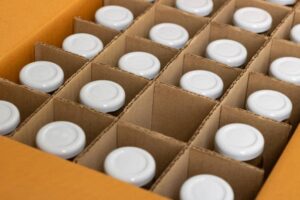PET, or Polyethylene Terephthalate, is a clear and durable plastic used to make soft drink bottles. It is non-toxic and lightweight, making it an eco-friendly choice for PET packaging meaning. It is also thermally stable and recyclable. Most PET containers are clearly labelled with 1 in the universal recycling symbol.
It is a form of polyester.
 PET (polyethylene terephthalate) is one of the world’s most widely used and recycled plastics. It is a clear, strong, and lightweight polyester with many household and industrial uses. It can be shaped into bottles, containers, and other products. It is also often used in manufacturing textiles and clothing. In addition, it can be recycled again and again without losing its valuable properties.
PET (polyethylene terephthalate) is one of the world’s most widely used and recycled plastics. It is a clear, strong, and lightweight polyester with many household and industrial uses. It can be shaped into bottles, containers, and other products. It is also often used in manufacturing textiles and clothing. In addition, it can be recycled again and again without losing its valuable properties.
PET is a clear plastic that can be moulded into bottles and containers in its most common form. It is also used to make sheets, jars, and punnets for packaging food and other products. It is commonly labelled with the recycling number’ 1′. Bottles and containers made from PET are safe for beverages, food, personal care items, and household cleaners. They are approved for use by global health authorities and are a cost-effective alternative to glass, aluminium, and steel.
Like other forms of polyester, PET can be morphed into various shapes. However, moulding PET is a complex and time-consuming process that requires a precise temperature control system. To ensure the PET is moulded into the right shape, it must be heated to the appropriate temperature and cooled rapidly. The speed at which it cools determines the final size of the product.
Unlike other plastics, PET does not contain BPA or dioxins and is safe to use with food and beverages. In addition, it has a high strength-to-weight ratio and is virtually shatterproof. This makes it a popular choice for food PET packaging meaning https://www.mindbodygreen.com/articles/do-vitamins-expire. It is also easy to recycle.
When first synthesised in the 1940s, PET was a polymer used to create textile fibres. Then, during the 1950s, scientists discovered how to stretch it thin, resulting in a form of plastic known as PET film. This form is now used in packaging and video and X-ray films. Then, in the early 1970s, researchers developed a process to blow-stretch PET, creating a state of polyester that was strong, transparent, and nearly impervious to gas and liquid. The result was PET bottles, which were much cheaper than their container predecessors and took up less landfill space.
It is durable
Unlike glass or aluminium bottles, PET bottles are highly durable. They are also lightweight, making them easy to transport and handle. They can also be manufactured to have various colours and designs. These features make them a popular choice for food and beverage packaging. They are also recyclable, reducing the amount of waste produced. Additionally, PET is thermally stable and can be resealed repeatedly without losing its integrity or appearance.
The durability of PET is due to its strength and rigidity, which allows it to withstand high temperatures without deforming or melting. It is also non-toxic, which makes it safe for food and drink packaging. In addition, it has excellent gas barrier properties and can undergo HPP (high-pressure processing), which is a heat-free form of pasteurisation.
A wide variety of products are packaged in PET, including beverages, water, peanut butter, salad dressings, pasta sauce, beer, wine, spirits, produce, and candy. The FDA and other regulating bodies have tested and approved these products. Despite these advantages, some consumers are concerned about the safety of PET plastics. To ensure you purchase a safe and hygienic product, look for the “BPA-free” label on the package.
Although PET was first synthesised in the 1940s, it didn’t become common for bottles until 1977. It has since been recycled and reused for countless applications, becoming one of the most popular and versatile types of plastic. Moreover, it is highly durable, transparent, and lightweight. It is also chemical-resistant and resistant to attacks from microorganisms, making it an ideal PET packaging meaning material.
PET is an excellent alternative to glass or metal containers because it is safe for beverages and foods. It is also easy to recycle, reducing energy consumption and landfill space. It can be recycled into a new container using a combination of mechanical and thermochemical recycling processes. It can also be chemically broken down into component materials and remoulded into a new plastic bottle. This versatility makes it a valuable part of the circular economy.
It is lightweight
PET is one of the most common plastics in the world, and it’s a big part of your everyday life. It’s used for water bottles, shampoo containers, soda cans, and fabric products. Its low weight means that it uses less energy for production and transportation. It also leaves a smaller carbon footprint than its glass counterparts. It’s also a safe, non-toxic, lightweight, and durable material that can be recycled repeatedly.